The single most effective way I know of to study the Bible in our digital age
Hi Dojo readers,
I was watching the kickstarter video for the new Bibliotheca project that is in the works (which you should go check out HERE if you haven’t already seen it!), and it got me thinking about something I’ve shared for years with folks in the classes I teach, but have never shared in a blog post.
We live in an age where the technology we have just in our PHONES alone gives us more access to Biblical studies than every person in the history of God’s people COMBINED had access to in the history of mankind. Think about that for a minute and let it sink in.
…
…
…
It is simply staggering when you actually realize the implications.
And while the rise of modern telecommunications and the digital/computer age have produced many new ways for evil and sin to flourish, it has also produced the ability to study and understand Inspired Scriptures in ways that are revolutionary…and no, I’m not talking about those silly “Bible Code” approaches some people seem so fascinated by (spoiler alert: they’re bogus!).
In fact, one of the absolute most effective ways to study the Bible that I have ever found is available absolutely free for any Christian in the world with internet access and a word-processing program. And that is what I want to share with readers today. Because it’s the way I prepare for Bible studies I lead when I really want to understand a book in Scripture as a whole and the flow of thought within it.
You see, the original Scriptures in their original languages did not have verse numbers.
They didn’t have chapter numbers.
They didn’t even have spaces between the letters originally!
Here’s an example of what a New Testament text looked like when it was first being circulated among the early churches:
ITWOULDREADLIKETHISTOTHEORIGINALAUDIENCEANDTHEYWOULDKNOWWHERETHEWORDSWERESU
PPOSEDTOBEDIVIDEDBECAUSETHEYWEREUSEDTOREADINGTHISWAYANDBECAUSEMOSTOFTHETIMESC
RIPTUREWASREADOUTLOUDRATHERTHANBYINDIVIDUALSANYWAY.
Now of course modern English (which you speak and/or read if you’re reading this post!) has things like spaces, punctuation and paragraph indentations, all of which help us determine the writer’s intended message. But sometimes, due to printing/cost constraints, it is not feasible to print the Scriptures for modern English readers in ways that make the best sense literarily. In the past, publishers would print each verse as a new paragraph for some translations (see the old KJV or NASB for example). With the demand for thinline and pocket-sized Bibles, publishers often use the two-column approach which allows more text per page…but doesn’t accentuate reflective, thoughtful reading to many English readers.
And the presence of chapter and verse numbers in most printed Bible translations end up dominating the page (see the print version of the NET where each verse also include the chapter number right beside it, for instance) and break the passage up in ways that the original Biblical authors never intended–such as the unfortunate chapter break between Genesis 1 and 2.
On top of that, the decisions as to where paragraphs should begin and end are 100% made by the translators/editors/publishers of the various printed Bible translations rather than being part of the original Inspired text itself. Most of the time this doesn’t make a huge difference…but sometimes it definitely does!
So with all of this in mind, one way I have found to be TREMENDOUSLY helpful in really reading and studying the Bible in detail and understanding the literary flow of Scripture’s library of texts is by using a simple process that forces me to interact with the text in a way that no printed version ever could. I invite you to try it for yourself and see if you don’t gain so much more from ANY book of the Bible than you ever have before.
Step 1: Choose a translation
If you don’t have the ability to read or translate the text from its original language/s (Hebrew, Aramiac and/or Greek) then you’ll need to choose a translation that you can work with. There is no “best” or “most accurate” translation in modern English. EVERY translation is an interpretation. Period. Anyone who claims otherwise is being dishonest or is ignorant of how Bible translation works in real life. For the purpose of study, I suggest choosing a translation that is somewhere in the middle of the spectrum between word-for-word and thought-for-thought (for more on these and the issues involving translations, I highly recommend the Disciple Dojo resource “The Bible for the Rest of Us“…and not just because I produced it! 🙂 )
Fortunately, most English translations are available for FREE online! There are many places you can go, but I recommend in particular Bible Hub, Biblia.com, or Bible Gateway (Bible Gateway is nice because it has the RSV and NRSV, which many critical scholars prefer and which I grew up with as a good Methodist!)
Step 2: Choose a book of the Bible
This is based on whichever book you want to understand better or whichever one you are studying in small group, Sunday School or seminary/Bible college. For this example, I’m going to use the book of Jonah since I’m an OT guy and it’s one of my favorite books to teach.
Step 3: Open a blank word processor document
I’m not a hipster, so I’m using PC. But if you’re a Mac user, I’m sure you can find an equivalent to this step! 🙂 For this example, I’m using Microsoft Word, but the open-source Word-like programs out there all do the same thing basically so it shouldn’t be a problem if you’re computer savvy enough to have found this blog in the first place!
Step 4: Copy the text of your Bible book
In your online Bible resource noted above, go to the first chapter of the book you’re studying and use your mouse/touchpad/touchscreen/whatever to highlight the entire text of the chapter. Then copy it by either selecting “copy” from the edit menu, right-clicking and selecting “copy” from the pop-up menu, or just hit “CTRL + C” (my preferred method).
Step 5: Paste the UNFORMATTED text into your blank document
Here’s the key to the whole thing! Go to the Word document you’ve opened and paste the text into it. But make sure to paste the text UNFORMATTED. In Word, you do this by choosing “Paste Special” from the “Paste” menu at the top left of the screen. When you do this, it removes any text formatting and hyperlinks and paragraphing. If when you paste the text there are still paragraph breaks in the passage, just delete them so that you are left with a block of text.
Step 6: Repeat for the remaining chapters of the book
Obviously if you’re studing 3John or Jude or Nahum this will be a very quick process. If you’re studying Psalms, Jeremiah or Acts, then you may want to break this step up and do it for 5-10 chapters at a time. With Jonah, it’s just 4 chapters so it only takes a few minutes
Step 7: Save your Word file
Now that you have the entire text of the book in a single, unformatted word-processor file, save it to your computer/device with a filename that will let you identify it easily. For instance, I would save mine as “JONAH_TEXT.doc” or something like that.
Step 8: Add spaces, paragraphing, punctuation and notes
THIS is where the real payoff is! As you read through the text in your word document go through and begin adding your own formatting. Decide where the paragraph begins and ends and indent/space it accordingly. As you go, I recommend either deleting or making into superscripts the chapter and verse numbers. Delete any cross-references or footnotes you may have copied (though take note as you go if some of the footnotes are insightful or important and if so, note them either in the side margin or in brackets or some other way that you find helpful). And be sure to delete any paragraph headings or subject headings that your translation may have put in the text at the beginning of various passages (i.e. “Instructions about the Tabernacle” or “Jesus heals a blind man” etc.)
I usually set up the margins of my Word document so that there is a good 2″ or 3″ margin on one side of the page (usually the right, since I’m right handed). In that margin, I create a text box by selecting “Text box” from the “Insert Shape” menu and I use that for adding any notes, alternate translations, cross references, or quotes from commentaries I come across as I study the book. This is not a necessary step, but I find it especially helpful and recommend doing it if you can.
During this process of formatting the book on your own, you will likely be forced to make interpretive decisions that you would have never thought about by simply reading a printed/formatted text. You may find that a train of thought runs all the way through a number of verses and they all belong to the same paragraph after all. You may find that a new thought beings in the middle of a verse and the text should be separated there instead. You may come across a list of things that are hard to keep in mind when read in paragraph format and so choose to put each one on a separate line to create the list feel that the text gives (this is especially helpful in genealogies!) and to see the importance of the number of items listed that you might have otherwise missed (this is ESPECIALLY helpful in Matthew’s opening genealogy!).
The important thing is not that you get it “right”, but rather that you are forcing yourself to interact with the text at the literary level and really absorb its content and how to best present that in terms of clarity of reading. You will find yourself reading and rereading a passage and perhaps realizing that it could legitimately be read two different ways depending on how it’s spaced/punctuated, etc. This is exactly what this type of studying is supposed to do! To get you to not just read the text…but to actually READ the text. To THINK THROUGH the text. ON YOUR OWN before consulting any commentaries, study guides or study Bible notes.
You won’t end up with a “perfect” formatted text. Rather, you’ll end up with a text that you have genuinely worked through and thought through and are so much more familiar with after having done so!
Step 9: Save your formatted book file
Once you’ve formatted your book of the Bible (or actually, having done so multiple times along the way so that you don’t accidentally lose your file due to a power outage or accidental keystroke or any of the other things that make us want to throw our computers across the room when they happen!) save it with a different name that distinguishes it from the unformatted version. For example “JONAH_EDITED.doc”. And if possible, save a copy of both versions on a flash drive or memory card as well! That way, you can share it with others or on multiple computers/devices.
Step 10: Use your new formatted digital book file alongside your various Bibles when studying or teaching
As you continue to study the book, you may find that you need to go back and re-edit parts of it. You may come across other translations that you think work better in certain passages of it. No translation is perfect and the beauty of this whole process is that with a simple cut-and-paste you can create study notes, alternate translations, insert footnotes, underline, highlight, make bold, or change font color in ways that help the text make better sense to you.
For example, when I was doing this with the book of Revelation, I found it helpful to put all of the quotes or references to passages in the Hebrew Bible in bold italics and to indent them. This allowed me to easily see just how much Revelation draws from the Old Testament and the frequency with which John does so. I also put in small paretheses beside each one the actual verse reference being alluded to or quoted. This allows me not only to easily identify which books John is quoting throughout, but it also helps to instill in my visual memory the passage in the OT that is being referenced each time I read it.
Or when doing this with the book of Romans, I would put spaces between each rhetorical section of the book so that I could more easily see when Paul is changing voice/character in his diatribes throughout the letter. Of course there are points at which it is heavily debated whether or not he is speaking as himself or as his rhetorical interlocuter, but that is what you learn as you continue to study the book throughout your life and further develop your Biblical-theological views.
When doing this with a book in the Hebrew Bible, you are forced to note and figure out a way to better communicate visually the structure and patterns of Hebrew poetry (which is practically EVERYWHERE in the OT!). Many passages that are formatted in most translations as simple paragraphs are actually poetic. So, for example, on the 6th “yom” (day) of Genesis 1, when God creates “adam” (human), we come across the first poem in the Bible in v.27. The tri-partite structure of the verse provides a MAJOR clue as to how we understand the concept of the “image of God” that might otherwise be missed by just reading it as a prose paragraph (I’ll let you study that verse on your own to find out what I’m talking about). In some books, such as the Song of Songs (aka. Song of Solomon) it is impossible in places to identify exactly who is speaking. This is when using colors can be especially helpful–as I’ve done here in the Dojo, in fact!
It also becomes very helpful in narrative portions of Scripture where there is dialogue. Instead of reading it all in a block paragraph, you can format the dialogue like modern English dialogue reads in novels or plays, thus more easily keeping track of who’s speaking and how the conversation is going.
Another really helpful thing is the ability to add punctuation. All punctuation in any Bible translation has been added by the translators…and often they don’t do justice to the tone of the text. There are times when an exclamation point (or three!!!) are needed to convey the force of the passage. There are times when USING ALL CAPS can help bring out the emphasis when the author seems to be “shouting” (in modern digital lingo). These are all things you can decide and add to your formatting to help bring out the meaning of the text.
And if you don’t have a tablet or mobile device that you can take with you to Bible study/Sunday School/class or wherever it is you want to read and study at the time, you can print out the word file and take it with you. That way you haves something to scribble notes on, highlight, underline or whatever else you may want to write on it which you can then easily edit into your digital file when you get back to your computer.
“But what if I get it wrong?? Isn’t this “adding to” God’s Word??”
No.
You are not producing a translation to take the place of your Bible! You are doing an exercise in study…and it’s okay to be wrong when you’re studying! That’s part of the learning process. Part of the wrestling with God’s word that we are all called to do in whatever ways we’re able.
In the 1700s, John Wesley would read and reread Scripture in multiple languages and produce copious notes on nearly the entire Bible. I believe he would’ve been astounded and overjoyed if someone had given him the ability to format, copy and paste. I believe Bible readers throughout the millennia would be thrilled if they had the ability to digitally read, study and analyze the syntax and structure of the sacred texts in the ways we are able to now…even on our phones!
In the end, remember, the journey IS the destination. The purpose of this exercise is to get you to think through–to REASON through–the flow of the book as a whole. “Memory verses” are fine, but they don’t give you context. Doing the process I’ve suggested above is the single best way I have personally ever found to grasp the overall context–and thus the overall foundational teaching and “big idea”–of the various books that make up this library we call the Bible. In fact, in my DVD study “Revelation: A Guided Tour of the Apocalypse” I include in the workbook (which is available to download for free HERE!) the entire book of Revelation that I have translated and then formatted in this way if you’d like to see an example.
I invite you to give it a try, Dojo reader, and see if it doesn’t deepen your understanding and appreciation of whatever book you choose to study next.
Categories: Biblical Scholarship, Biblical Theology, Blog, Curriculum, Hebrew Bible, Ministry, New Testament, Teaching Products
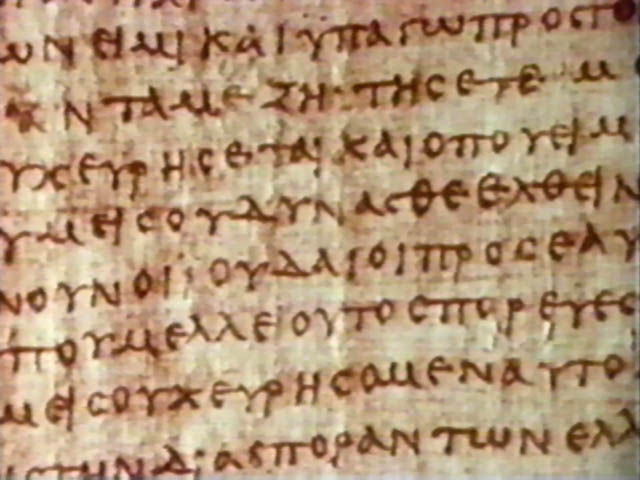
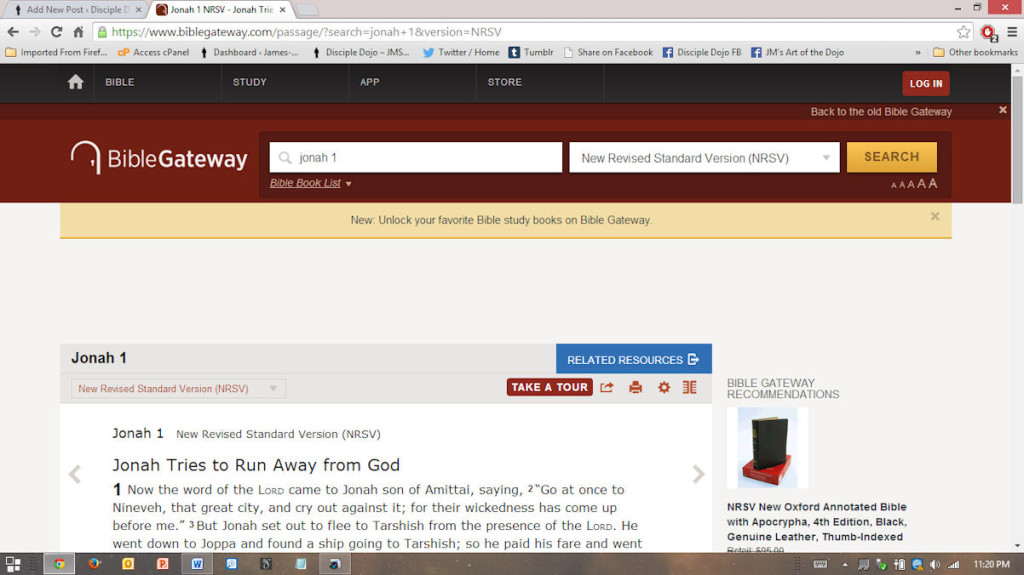
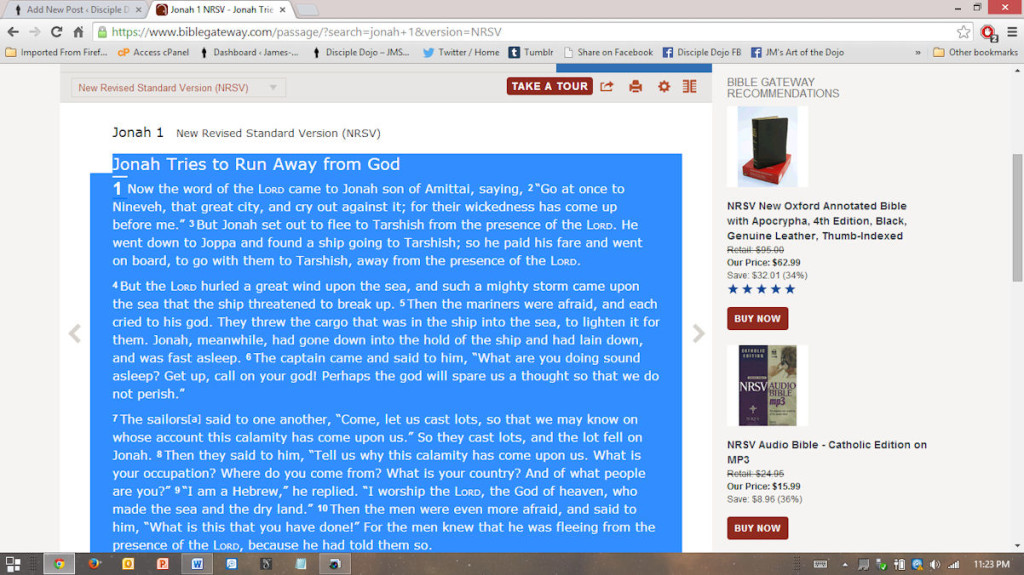
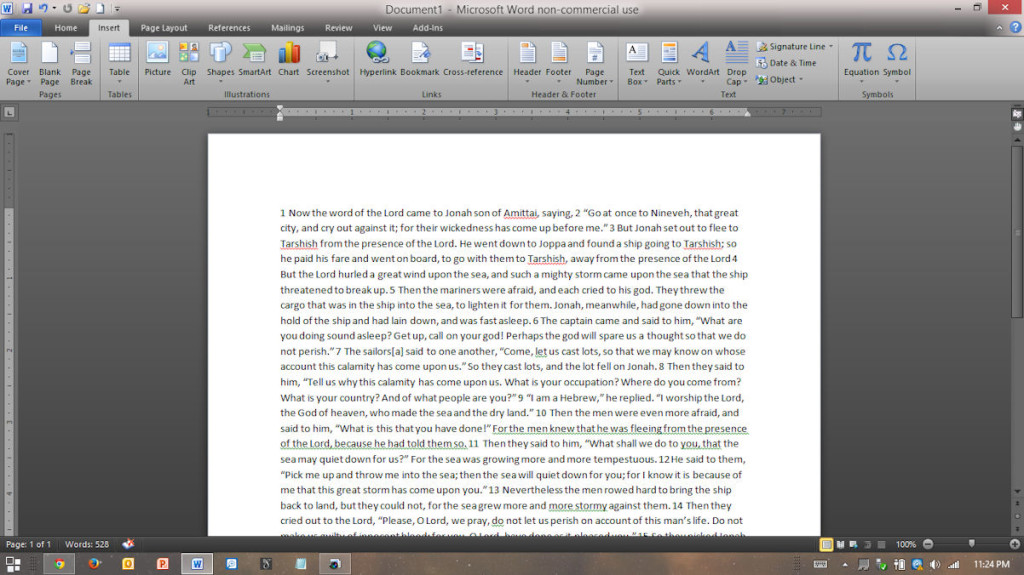
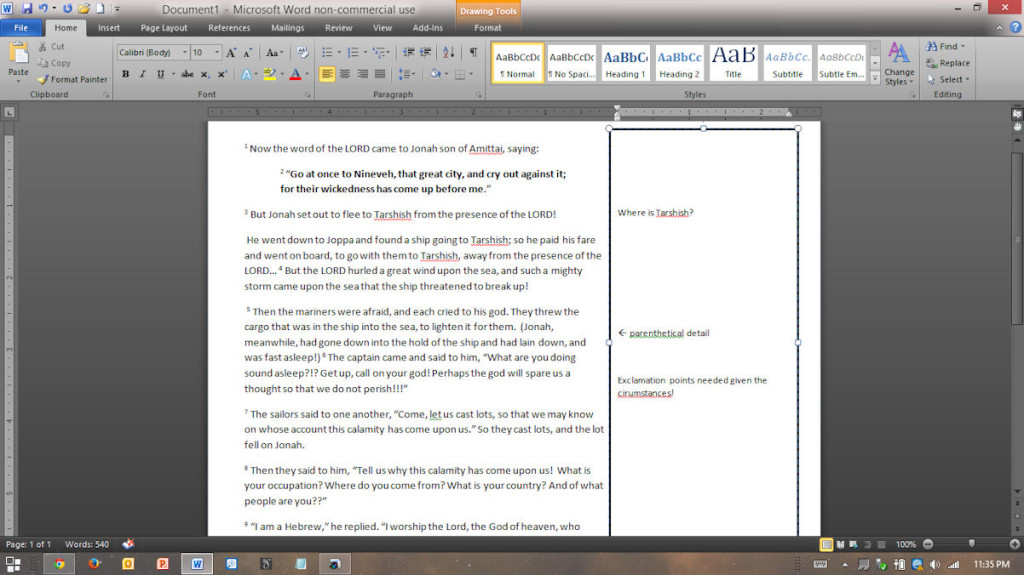
[…] sense of the overall flow of this most dense (and often confusing!) section of the book. So using the Bible study approach I suggested earlier this year (which I still believe to be the single most effective way of studying overall books of the Bible […]
by Disciple Dojo – JMSmith.org » Is Romans 9-11 a giant chiasm? [Bible geek alert] on Nov 4, 2014 at 4:15 am